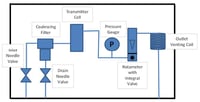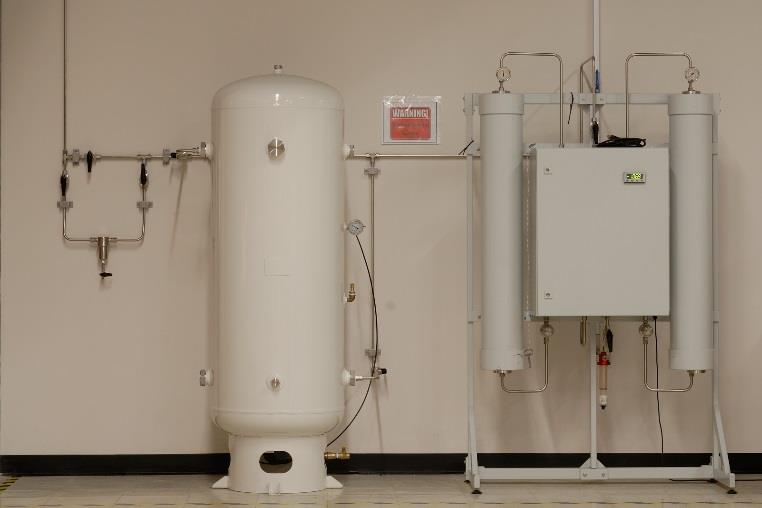Aluminum Oxide Dewpoint Transmitter Application Note - Instrument Air
Application Description:
Instrument air, or compressed air, is a very common utility found in most manufacturing facilities. It can be used in any number of applications from the pneumatic-conveying of material, to pneumatic power tools, to actuated valve control, to a cooling medium, to a drying medium, and many more. Another term for instrument air, sometimes used synonymously, is “plant air”. However, in general, plant air is considered to be of lesser quality, generally dirtier, and not dried to reduce its humidity level.
Why Dewpoint Measurement is desired/required:
Water vapor can be a major contaminant in instrument/compressed air. As mentioned above, plant air may have uses within a facility that do not require it to be of good quality. So, a plant air system may not be filtered to remove contaminants such as particulates or oils, and it may not be dried to reduce its water vapor content. However, instrument air usually is both filtered and dried.
The detrimental effects of poor quality instrument air can manifest in various ways including:
- Corrosion of equipment and piping systems
- Damage to manufacturing equipment
- Micro-organism growth
- Affect product quality
Factors to Consider Effecting the Dewpoint Measurement:
Because dewpoint is a function of the process pressure, the dewpoint is commonly measured at one of two convenient pressure levels: process pressure or atmospheric pressure. For a given water vapor content, the higher the process pressure, the wetter the dewpoint. The factors normally used to assist with this decision are usually either that the dewpoint at line/process pressure is required, so the dewpoint measurement is accurate for the process line conditions, or the gas is allowed to expand (normally over a needle valve) to atmospheric pressure, allowing for dewpoint readings that are always relative to atmospheric pressure. Also, atmospheric pressure dewpoint allows for easier conversion to a parts per million (PPMv) measurement because the pressure never varies from atmospheric pressure. In other words, the PPMv calculation will always be based on atmospheric pressure.
Typical Application Conditions/Parameters:
**ANSI/ISA–7.0.01–1996: Quality Standard for Instrument Air (Typical compressed air dryer types)**
- Regenerative desiccant dryers
- Regeneration with Heaters
Flow Range: 0 - 50,000 SCFM @ 100°F at 100 psig
Outlet Dewpoint Range at Line Pressure: -40°C (-40°F) - Regeneration without Heaters
Flow Range: 0 - 10,000 SCFM @ 100°F at 100 psig
Outlet Dewpoint Range at Line Pressure: -40°C (-40°F)
- Regeneration with Heaters
- Heat of compression dryers
- Flow Range: 0 - 10,000 SCFM @ 300°F at 100 psig
Outlet Dewpoint Range at Line Pressure: -18°C to 4°C (0°F to 40°F)
- Flow Range: 0 - 10,000 SCFM @ 300°F at 100 psig
- Refrigerant dryers
- Flow Range: 0 - 5,000 SCFM @ 100°F at 100 psig
Outlet Dewpoint Range at Line Pressure: 2°C to 4°C (35°F to 39°F) - Flow Range: 5,000 - 10,000 SCFM @ 100°F at 100 psig
Outlet Dewpoint Range at Line Pressure: 10°C (50°F)
- Flow Range: 0 - 5,000 SCFM @ 100°F at 100 psig
Equipment Recommended: 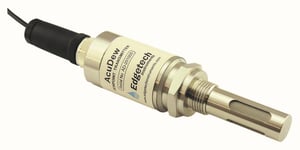
Product name and/or model number:
AcuDew Dewpoint Transmitter
Potential Sample Systems depending on the conditions of the instrument air line:
No particulates/No entrained liquids: CAM (Compressed Air Module)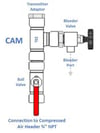
Particulates/No entrained liquids: Typical Sample System
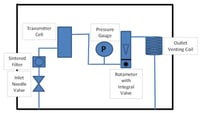
Entrained Liquids/Particulates: Typical Sample System
